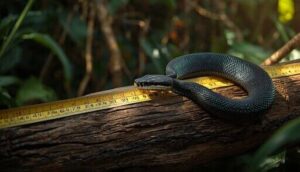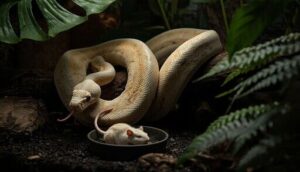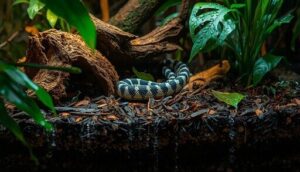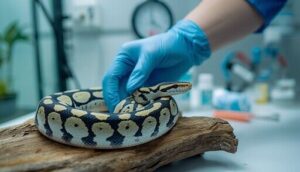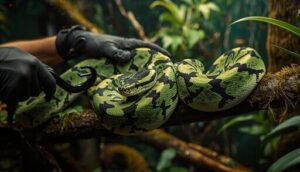This site is supported by our readers. We may earn a commission, at no cost to you, if you purchase through links.
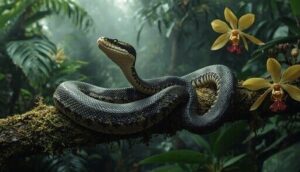
The white lipped python might not wear its name as boldly as a ball python wears its patterns, but this dark-bodied serpent from New Guinea’s rainforests has carved out a reputation that commands respect. With scales so dark they appear almost patternless and that telltale pale coloring around the mouth, these medium-sized constrictors blend into the shadowy canopy where they spend much of their nocturnal lives hunting.
They’re not the beginner-friendly python you’ll find curled up docilely at a reptile expo—their defensive temperament and specific care requirements demand knowledge, patience, and a healthy appreciation for their wild nature. Understanding their natural history, from the humid lowland forests they call home to their shifting dietary preferences as they mature, transforms keeping one from a risky endeavor into a rewarding challenge for experienced keepers.
Table Of Contents
- Key Takeaways
- What is a White Lipped Python?
- Where Do White Lipped Pythons Live?
- How Big Do White Lipped Pythons Get?
- White Lipped Python Behavior
- White Lipped Python Diet and Feeding
- Setting Up a White Lipped Python Enclosure
- Maintaining Proper Humidity and Hydration
- Health Issues in White Lipped Pythons
- Handling and Caring for White Lipped Pythons
- Frequently Asked Questions (FAQs)
- What is a white lipped python?
- Are white lipped pythons right for You?
- Are white lipped pythons Hardy?
- Where do white lipped pythons live?
- How big do white lipped pythons get?
- What are the different color variations of white-lipped pythons?
- What veterinary care do white lipped pythons need?
- How much does a white lipped python cost?
- Are white lipped pythons legal to own?
- What substrate works best for white lipped pythons?
- Conclusion
Key Takeaways
- White-lipped pythons are medium-sized constrictors from New Guinea’s rainforests that reach 5–7 feet (northern populations) or up to 9 feet (southern populations), requiring experienced keepers due to their defensive temperament and specific humidity needs of 55–85%.
- These nocturnal hunters shift their diet as they grow—juveniles start with lizards while adults prey on rodents and birds—and in captivity they need frozen-thawed prey every 7–14 days depending on age, fed in separate containers to prevent substrate ingestion.
- Proper enclosure setup demands at least 7’L x 3’W x 4’H for adults with climbing branches for their semi-arboreal nature, precise temperature gradients (88–92°F basking, 75–82°F cool side), and moisture-retentive substrates like cypress mulch or coconut husk layered 4+ inches deep.
- Their defensive behavior—including striking without warning, musking, and consistent stress responses—makes them unsuitable for beginners, requiring snake hooks for handling, protective gear during interactions, and realistic acceptance that they may never become docile despite years of patient care.
What is a White Lipped Python?
The white-lipped python is a medium-sized, non-venomous snake that calls the lowland forests of New Guinea home. You’ll recognize this species by its dark, nearly patternless body and the pale coloring around its mouth that gives it its common name.
Before you consider bringing one into your life, it’s important to understand what makes this python unique, from its scientific background to the distinctive features that set it apart from other pythons.
Scientific Classification and Taxonomy
At the heart of understanding White Lipped Pythons lies the genus Leiopython, currently encompassing three recognized species plus potentially others under review. Phylogenetic uncertainty means taxonomic revisions continue reshaping snake species taxonomy:
- Leiopython albertisii – Northern White Lipped Pythons
- Leiopython fredparkeri – Southern White Lipped Pythons
- Leiopython biakensis – Biak populations
- Leiopython hoserae – disputed status
- Nomenclatural history traces back to 1878’s original Liasis albertisii
Species recognition remains actively debated among herpetologists. These snakes are often found in New Guinea forests.
History of Discovery
The White Lipped Python’s story began in 1878 when Wilhelm Peters and Giacomo Doria described the species, honoring Italian explorer Luigi Maria d’Albertis. D’Albertis collected specimens during his pioneering Fly River expeditions from 1875 to 1877, becoming the first Italian to chart this Papua New Guinea waterway.
The White Lipped Python was first described in 1878, named after Italian explorer Luigi Maria d’Albertis who discovered it during his historic New Guinea expeditions
Since that Initial Description, Taxonomic Revisions have reshaped our understanding, with Modern Recognition now identifying multiple distinct Regional Populations across New Guinea. These pythons are part of the Pythonidae family, which includes several other python species.
Distinctive Physical Features
From those early expeditions, collectors noticed something striking: the vivid white labial scales that give this python its name. These snakes don’t just have one look—their appearance shifts with age and origin.
Key identifying features include:
- Contrasting head coloration: Adults display a shiny black head with distinct white upper and lower labial scales marked by vertical black edges
- Iridescent body scales: Smooth dorsal scales produce a rainbow sheen under certain lighting, ranging from brownish-violet to blackish-blue
- Ontogenetic color change: Hatchlings start uniformly dark grayish-black, developing lighter ventral surfaces and postocular spots as they mature
- Regional variations: Northern populations show brownish-golden tones with light eye markings, while southern forms appear darker with more black and gray
- Sexual dimorphism subtleties: Though color morphs don’t differ dramatically between sexes, size variations exist across populations
The body itself tells another story. You’ll count roughly 43–51 scale rows at midbody, with that characteristic fishnet pattern developing along the sides as darker scale edges emerge with growth. Head shape remains elongated and rectangular, clearly distinct from the muscular neck—a feature that helps you immediately recognize these semi-arboreal hunters in any collection.
Where Do White Lipped Pythons Live?
White lipped pythons come from a pretty specific corner of the world, and knowing where they naturally thrive helps you understand what they need in captivity.
These snakes are built for the warm, humid environments of New Guinea and its surrounding islands. Let’s look at exactly where you’ll find them in the wild and what conditions keep them healthy.
Native Range and Distribution
You’ll find White Lipped Pythons across New Guinea’s lowland forests and surrounding islands, where at least six species occupy distinct biogeographic regions within this Australasian zone.
The Northern whitelipped python ranges from Sorong eastward to Madang, while Southern whitelipped pythons inhabit western provinces. Island distribution extends to Biak, Mussau, and Salawati, with elevational limits usually below 1,200 meters reflecting their tropical lowland preferences and conservation context.
Preferred Habitat Types
In lowland tropical forests, you’ll discover the White-Lipped Python’s habitat, where rainforest occupancy reaches 80% below 1,200 meters, offering a dense understory and arboreal preferences up to 3 meters. Wetland access and riparian forests within 50-100 meters provide key hunting grounds, while microhabitat humidity around hides maintains the essential 75% moisture level this python needs to thrive.
- Forested swamplands: These maintain above 70% humidity year-round, reducing desiccation risk by half during dry seasons while offering 30% higher prey density than open areas.
- Stream basins and riverine zones: Moderate vegetation creates perfect ambush sites, with 60-80% relative humidity supporting nocturnal foraging within 200 meters of water.
- Semi-arboreal microhabitats: Low canopy branches and dense foliage at 1-2 meters shelter juveniles effectively, providing 25% of daytime retreats with secure hides.
Climate and Environmental Conditions
Because tropical lowland New Guinea experiences minimal seasonal variation, you’ll want to replicate temperature gradients of 24–28°C ambient with 31–33°C basking spots—mimicking the species’ stable native microclimate.
Humidity ranges between 55–85% support proper hydration, while thermal gradient control lets your python thermoregulate naturally.
Captive replication of these humidity levels and temperature control parameters prevents dehydration and ensures healthy shedding year-round.
How Big Do White Lipped Pythons Get?
If you’re planning to bring a White Lipped Python into your life, you’ll want to know how much space they’ll need as they grow.
These medium-sized pythons don’t stay small for long, and their final size can vary depending on several factors.
Let’s break down what you can expect with respect to their length, how quickly they reach full size, and whether their origin affects their dimensions.
Average and Maximum Sizes
You’ll want to know how much space your White Lipped Python truly needs, and that starts with understanding Adult Size. Northern animals generally reach 150–210 cm (roughly 5–7 feet), while southern populations can hit 9 feet or even push 10 feet in rare cases. Geographic Variation matters when planning Enclosure Size and Dimensions.
- Neonate Size: Hatchlings emerge around 38–50 cm, about one-sixth of adult length
- Body Proportions: Slender yet stocky build, more gracile than heavy-bodied pythons
- Maximum Length: Southern forms top out near 9–10 feet; northern rarely exceed 7 feet
- Captive Growth: Well-fed individuals approach the upper published range with proper care
Growth Rates and Maturation
Juvenile feeding every 5–7 days fuels explosive growth—hatchlings stretch from 7–10 inches to 3–4 feet within their first year.
Sexual maturity arrives around 2–4 years, when your python reaches 5–6 feet, though males generally beat females to reproduction.
Adult growth slows dramatically after that occasion, and lifespan duration in captivity can stretch past 30 years if environmental impact from temperature and prey quality stays ideal.
Geographic Variations in Size
Your White Lipped Python’s size isn’t random—it’s written in the map. Northern White Lipped Pythons (D’Albertis python) generally cap at 5–7 feet, while Southern White Lipped Pythons stretch past 8 feet, a latitudinal size difference tied to taxonomic revisions splitting the genus.
- Mainland variation runs east to west, with western populations showing higher ventral counts
- Island patterns on Biak and Emirau produce compact builds with distinct scalation
- Elevational variants in highland regions develop unique body proportions
- Southern lineages start larger as hatchlings and maintain that edge
- White Lipped Python species identity determines your adult snake’s maximum length
White Lipped Python Behavior
White lipped pythons are primarily nocturnal creatures, which means most of their activity happens under the cover of darkness. Their behavior reflects a fascinating mix of cautious temperament and instinctive hunting prowess that’s evolved over thousands of years in New Guinea’s rainforests.
Understanding how these snakes behave, both in the wild and in captivity, will help you provide better care and know what to expect from your python.
Nocturnal and Hunting Habits
You’ll find these pythons most active after dark, when they become active hunters rather than sit-and-wait predators. Sensory Adaptations—heat-sensitive labial pits and tongue-flicking—let them track warm-blooded prey items through dense forest at night.
This Temporal Activity pattern means you should offer feeding during evening hours for the best feeding response.
Their Foraging Strategies include ground cruising and low-branch climbing, with Prey Selection shifting from lizards in juveniles to birds and mammals in adults.
Temperament and Defense Mechanisms
Despite their hunting prowess, these snakes are more defensive than aggressive toward you. When threatened, they’ll adopt an S‑shaped defensive body language, hiss loudly, and may release a pungent musk—non-bite defenses that signal stress. Biting behavior usually involves quick strike-and-release rather than sustained attacks.
Locality variation matters: southern forms generally show calmer temperament than northern populations, making handling safer when you respect their stress factors.
Interaction With Other Animals
Beyond defensive behavior toward you, white-lipped pythons occupy a mesopredator role in New Guinea ecosystems, where interspecific competition with other medium-sized pythons shapes their niche. Predator vulnerability affects hatchlings—raptors and monitors readily take juveniles. Human interaction near croplands increases snake bites when a defensive temperament meets handling attempts, yet their ecosystem impact as rodent regulators benefits your landscape.
Three interaction layers you should understand:
- Wild coexistence – They share forest edges with four sympatric python species, partitioning activity times rather than territory to reduce competition for mammalian prey.
- Human‑wildlife overlap – Artificial lighting attracts rodents near homes, drawing pythons closer and raising bite risk when defensive snakes encounter curious pets or people.
- Trophic regulation – By preying on small vertebrates nocturnally, they balance prey populations that diurnal raptors miss, maintaining ecosystem health across their range.
White Lipped Python Diet and Feeding
White lipped pythons are carnivorous generalists, meaning they’ll eat just about any warm-blooded prey they can swallow in the wild.
In captivity, you’ll want to understand what they naturally hunt, how to replicate that safely, and the best practices to keep feeding time stress-free for both you and your snake.
Let’s break down what these pythons need nutritionally and how to deliver it without putting anyone at risk.
Natural Prey in The Wild
In the wild, you’ll find these pythons shifting their White Lipped Python diet as they grow—young snakes often start with lizards and small reptiles, while adults focus mainly on mammalian prey like rodents and small birds.
Their foraging strategy is active rather than passive, using heat-sensing pits to hunt warm-blooded prey at night. This diet shift reflects their increasing size and hunting capability.
Feeding in Captivity
When you bring a White Lipped Python home, you’ll want to establish a feeding schedule that mirrors their natural rhythms.
Hatchlings need fuzzy mice every 7 days, juveniles eat every 10-14 days, and adults do well on medium-large rats every 14-21 days.
Prey size should match your snake’s widest point, and frozen-thawed rodents work best for safety and health monitoring.
Safe Feeding Practices
Because White Lipped Pythons can mistake your hand for prey, always use long feeding tongs to deliver meals—and never handle your snake for 24–48 hours afterward to prevent regurgitation.
To keep feeding habits safe and healthy:
- Thaw frozen rodents in sealed bags using cool water to limit bacterial growth
- Feed in a separate tub to avoid substrate ingestion and keep prey preparation clean
- Remove uneaten prey within 4–6 hours to prevent decomposition and infection risk
- Track body condition regularly to adjust your feeding schedule and prevent obesity
Proper portion control protects your snake’s long-term health.
Setting Up a White Lipped Python Enclosure
Setting up the right enclosure for your white lipped python isn’t just about picking any old tank—it’s about creating a space where this semi-arboreal snake can actually thrive. You’ll need to get three critical elements right from the start: size, temperature, and what you put inside.
Let’s break down each component so you can build an enclosure that keeps your python healthy and comfortable.
Minimum Size Requirements
You’ll need to match your enclosure size to your python’s life stage. Hatchlings thrive in 15-20 gallon terrariums measuring roughly 30″L x 12″W x 12″H.
Once your snake hits 3 feet, upgrade to minimum dimensions of 36″L x 18″W x 18″H.
Adults demand serious space—think 7’L x 3’W x 4’H for these 6-7 foot beauties, with at least 2-foot cage heights for their semi-arboreal nature.
Temperature and Lighting Needs
Your thermal gradient is the lifeline of proper python care. Set your basking spot at 88–92°F and keep the cool side between 75–82°F. Monitor both zones with digital probe thermometers to confirm your heat sources maintain these zones. At night, allow a slight temperature drop to the mid-70s. Consider low-level UVB lighting on a 12-hour cycle, though it’s optional for these nocturnal hunters.
Essential temperature checkpoints:
- Basking area: 88–92°F for digestion and metabolic health
- Cool zone: 75–82°F for thermoregulation retreat
- Nighttime ambient: low-to-mid 70s°F mimics tropical conditions
- UVB bulb: modest intensity, timer-controlled for day cycles
- Thermostats: prevent overheating and burns from heat sources
Substrate and Enrichment Choices
Natural substrates like coco husk, ReptiSoil, or organic topsoil layered at least 4 inches deep let your python burrow and help lock in that 55–85% humidity sweet spot. Paper substrates work during quarantine but won’t hold moisture.
Add leaf litter, sturdy branches, and multiple hides—enrichment choices that trigger natural behaviors. Studies show enriched environments with sensory elements and deep substrate even increase brain development, reduce stereotypy, and improve overall welfare in captive snakes.
Maintaining Proper Humidity and Hydration
White Lipped Pythons come from the humid rainforests of New Guinea, so keeping moisture levels right isn’t optional—it’s essential for their health. Without proper humidity and access to fresh water, these snakes can struggle with shedding, dehydration, and even respiratory problems.
Let’s break down the key factors you need to monitor to keep your python hydrated and thriving.
Humidity Levels for Health
Your white-lipped python depends on humidity like we depend on air quality—get it wrong, and health problems follow fast. Maintaining humidity between 55% and 85% prevents dehydration signs like wrinkled skin and aids healthy shedding cycles.
Critical humidity maintenance tips:
- Monitor levels daily with digital hygrometers for accurate humidity control
- Boost humidity during shedding to prevent stuck shed pieces
- Watch for respiratory health issues or scale rot, both linked to improper humidity levels
Consistent humidity monitoring protects against potential health issues before they become serious.
Water Bowl Placement and Cleaning
Positioning your python’s water bowl strategically controls humidity while meeting water requirements. Place it near—but not directly under—your heat source to leverage the thermal gradient: warmer placement boosts evaporation for humidity control, cooler spots reduce it.
Choose safe materials like sturdy plastic or ceramic to prevent tipping and drowning risks in young snakes.
| Task | Frequency |
|---|---|
| Water replacement | 2–3 times weekly, or when soiled |
| Full scrub and disinfection | Weekly to biweekly |
| Biofilm prevention check | During each water change |
| Spill management inspection | Daily |
Signs of Improper Hydration
Beyond maintaining your water bowl, you’ll need to watch for dehydration indicators and overhydration risks that signal humidity level problems. White Lipped Python care demands vigilance for health issues like:
- Wrinkled, accordion-like skin lacking elasticity
- Sunken, dull eyes with cracked eye caps
- Lethargy accompanied by feeding refusal
- Shedding issues with stuck shed on extremities
These ocular changes and behavioral signs require immediate water and hydration adjustments.
Health Issues in White Lipped Pythons
Even the hardiest snakes can fall ill if their care isn’t quite right, and white-lipped pythons are no exception. You’ll want to watch for a handful of health problems that crop up more often than others in captivity.
Let’s walk through the most common issues you might encounter and how to keep your python in top shape.
Common Diseases and Parasites
Beneath the surface, even healthy-looking white-lipped pythons can harbor troublesome hitchhikers. Mites plague nearly 30% of wild-caught snakes, causing anemia and skin irritation, while gut parasites infect more than 60% of reptiles tested—some carrying multiple species at once. Bacterial infections and viral threats round out the risks, especially when trade conditions compromise immunity.
| Threat Category | Key Risks |
|---|---|
| Ectoparasite Prevention | Mites, ticks; upto 40% of imports affected |
| Gut Parasites | Nematodes, coccidia; 64% show co-infections |
| Bacterial & Viral | Mouth rot, septicemia, paramyxovirus |
Preventing Scale Rot and Respiratory Infections
You can dodge two of the most dangerous threats—scale rot and respiratory infections—through simple, daily choices. Maintaining temperatures between 78–82°F ambient and 88–92°F basking, combined with 70–90% humidity and a fast-drying substrate, slashes your risk dramatically.
Spot-clean daily, disinfect weekly, and quarantine new arrivals for 30–90 days to keep respiratory viruses out of your collection.
Obesity and Weight Management
Obesity sneaks up fast in these thick-bodied snakes—scale wrinkling, skin showing between scales, or a rounded “tube” shape signal trouble. Evaluating body condition takes practice, but catching it early prevents fatty liver disease and shortened lifespan.
Dietary adjustments matter: feed appropriately sized prey every 7–14 days for adults, never power-feed, and pair correct portions with exercise enrichment like climbing branches to keep your python lean and thriving.
Handling and Caring for White Lipped Pythons
White Lipped Pythons aren’t exactly beginner-friendly as far as handling goes, and understanding their temperament is key to keeping both you and your snake safe.
These powerful constrictors require respect, patience, and a thoughtful approach if you’re hoping to work with them successfully.
Let’s cover the essential techniques, realistic expectations, and practical strategies for managing these notoriously defensive pythons.
Handling Techniques and Safety
Handling a white-lipped python demands respect—this species often strikes without warning, so you’ll need a solid plan before opening the enclosure. Snake handling requires careful attention to safe restraint, bite prevention, and timing to keep both you and your python secure.
- Use a snake hook to guide the body and avoid direct hand contact near the head
- Wear protective gear like thick gloves and eye protection during initial interactions
- Limit handling duration to just a few minutes until your snake remains calm
- Guarantee enclosure security with escape-proof latches to prevent unplanned encounters
Always support the entire body length, never lifting by the tail, and avoid handling during shedding or after feeding. Preventing snake bites starts with reading your python’s body language and respecting its space.
Suitability as Pets
White-lipped pythons aren’t ideal for beginners—they’re advanced-level pets with serious temperament concerns and defensive behavior that demands experience. Their husbandry sensitivity, combined with large enclosure demands (minimum 6x2x2 feet), makes them challenging even for seasoned keepers.
| Challenge | Requirement | Risk |
|---|---|---|
| Temperament | Defensive strikes, musking | Snake bites common |
| Enclosure Demands | 200+ gallons | High setup cost |
| Husbandry Sensitivity | 55-85% humidity, precise temps | Health Risks |
Handling these pythons requires protective gear and patience. Their 30-year lifespan means you’re committing decades to managing a snake that may never become docile, so weigh whether a White-lipped python as a pet truly fits your experience level.
Tips for Taming and Reducing Stress
Through gradual desensitization and environmental improvement, you can reduce stress in even the most defensive white-lipped python—but it takes patience and strategy. Start with minimal handling frequency (5-10 minutes, 2-3 times weekly) while letting your snake adjust over weeks, not days.
- Provide secure hiding spots on both warm and cool sides to minimize exposure anxiety
- Improve temperature gradients (88-92°F warm side, 75-82°F cool) to prevent thermoregulatory stress
- Use a snake hook for initial interactions to avoid triggering defensive behavior
- Add enclosure enrichment like climbing branches to encourage natural exploration
- Maintain predictable routines for feeding and cleaning to build trust
Taming defensive snakes requires respecting their temperament—rushing the process only reinforces striking and musking responses.
Frequently Asked Questions (FAQs)
What is a white lipped python?
Like a living shadow draped in iridescent armor, this New Guinea native belongs to the family Pythonidae—a non-venomous constrictor known scientifically as Leiopython albertisii, distinguished by glossy black heads and contrasting white labial scales.
Are white lipped pythons right for You?
These snakes demand serious commitment—expect 20-30 years of care, substantial space requirements, and ongoing costs.
Their defensive temperament and sensitivity make them challenging for beginners, best suited for experienced keepers accepting minimal handling.
Are white lipped pythons Hardy?
Think of hardiness as a snake’s shock absorbers—White Lipped Pythons don’t handle bumps well.
Their high husbandry demands, stress reactivity, and disease susceptibility mean you’ll need precision, not luck, to keep them thriving long-term.
Where do white lipped pythons live?
You’ll find these pythons across New Guinea’s lowland tropical forests below 1,200 meters, plus nearby islands like Salawati and Biak.
They favor humid, water-rich habitats—think riverbanks, swamps, and wetland edges where prey thrives.
How big do white lipped pythons get?
You might expect a seven-foot python to feel massive, but white-lipped pythons stay surprisingly manageable—adults usually reach five to seven feet, though southern D’Albertis python populations can stretch closer to nine feet in rare cases.
What are the different color variations of white-lipped pythons?
You’ll see two main color phases: the northern “gold phase” with bronze-to-gold flanks, and the southern “black phase” displaying nearly uniform blackish-blue coloring. Both develop stunning rainbow-like iridescence as adults.
What veterinary care do white lipped pythons need?
You’ve probably heard that reptiles hide illness until it’s too late—and that’s largely true. Annual exams catch hidden respiratory infections and parasites early.
Quarantine protocols prevent disease spread, while monitoring husbandry impacts helps avoid common issues before urgent signs appear.
How much does a white lipped python cost?
You can expect to pay between $250 and $800 for this exotic pet snake species. Breeder reputation, morph costs, and market availability influence pricing, with initial investment including enclosure setup beyond the python’s purchase price.
Are white lipped pythons legal to own?
The legality of this exotic pet snake varies dramatically worldwide. US regulations differ by state, EU laws require permits in many nations, and Australia enforces a complete ban on non-native reptile pet care.
What substrate works best for white lipped pythons?
You’ll want moisture-retentive substrates like cypress mulch or coconut husk, layered at least 4 inches deep to support humidity retention and burrowing behavior while preventing mold through proper ventilation and regular spot-cleaning.
Conclusion
Your white-lipped python’s midnight-dark coils will one day seem less mysterious—not because they’ve changed, but because you’ve learned to read the language of their stillness and movement.
These New Guinea constrictors don’t soften into docility like some species, but they do reveal patterns: the hunger cues, the defensive triggers, the humidity needs that prevent shedding disasters.
Master those rhythms, and you’ll find that what seemed impossibly wild becomes something rarer—a manageable challenge that rewards your dedication.
- https://amphibian-pug-rzk5.squarespace.com/s/WhiteLippedPython.pdf
- https://zslpublications.onlinelibrary.wiley.com/doi/full/10.1111/jzo.13092
- https://grokipedia.com/page/D'Albertis_python
- https://www.sciencedirect.com/science/article/abs/pii/S1055790320302323
- https://en.wikipedia.org/wiki/D%27Albertis_python


